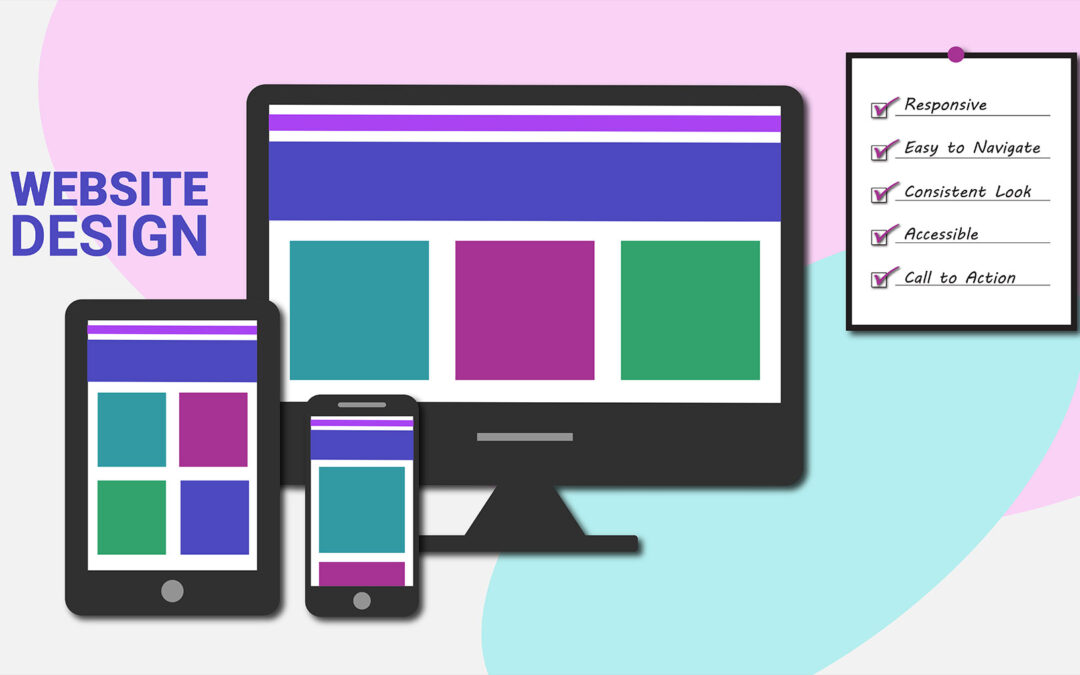What are the top principles of excellent website design? Websites must be responsive, easy to navigate, and designed to search well while maintaining accessibility standards. In addition, the site needs to reflect your brand’s identity. Let’s dive in a little deeper.
1. Responsive Design
Nearly half of all web traffic is completed by visitors using a smartphone or tablet. A responsive website design will function correctly on mobile phones and tablets. An excellent website designer knows to design with mobile functionality in mind and test it to ensure the website functions automatically and entirely on various size screens, from small mobile phone sizes to a widescreen television.
2. Easy to Navigate
Designing a website that is easy to navigate is imperative to a positive user experience. Most of us have been to a website where we couldn’t find what we were looking for quickly and left in frustration. It’s important to design for your customer, so they can find the information they need quickly. All content needs to be clearly labeled and organized. Choosing fonts that are easy to read, as opposed to more decorative fonts, is equally important in keeping with easy to navigate.
3. Accessibility
An excellent website explicitly needs to be inclusive to all. An outstanding web designer will test the website to be sure it functions and displays correctly on all browsers. Websites should also be accessible to people with disabilities. The most common impairment is vision. Color blindness affects about 8% of men and 0.5% of women. Adults as young as 40 start to lose their ability to read small print. To ensure that your website is visually accessible, you want to have a strong contrast between your text and background color.
To pass all of the Web Content Accessibility Guidelines (WCAG) be sure that your color contrast ratio is 7:1 for paragraph text and 4.5:1 for headlines with a larger font. Add alternative or “alt” text to images for visually impaired people. Paragraph text should be a minimum of 16px, and headlines should be a minimum of 18px. If you have videos, you need to add captions for hearing-impaired people or those who prefer to watch videos without sound, which is very common.
4. Consistency
Another key point of excellent website design is that a consistent look is essential to convey trustworthiness. Suppose different pages have different fonts, colors, or branding design elements. It can subconsciously signal to your visitor that they may be on another site, resulting in them leaving your site. Most people know there is some risk of potentially malicious websites and the dark web. Don’t risk sending the wrong message.
5. A clear call to action is equally important
Whether you offer a product or service, you should have a clear call to action so your visitors can easily purchase your product or service or contact you. Make your Buy Now or Contact Us buttons prominent on your website.
Excellent website design principles
Excellent website design is accomplished following many principles, these are my top 5. Focus on the user experience (UX) to design a website that is clear, easy to navigate, on multiple devices, and accessible to all.
- Be sure your website works properly on all browsers and devices.
- Keep the design simple so visitors can find information easily
- Use easy-to-read fonts, and ensure enough contrast between the background and text.
- Keep the design elements consistent.
- Make your CTA clear and easy to find
Finally, another essential consideration is search engine optimization (SEO) to make your website visible on Google.
